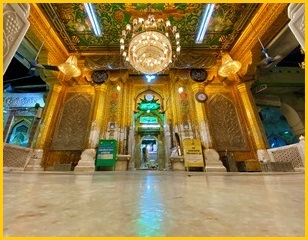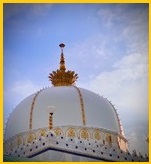Chishtiya Sufi Mission
Genealogy and history of Syedzadgan Khuddam e Khawaja (Harke-Khidmat Kard Makhdum Shud)

Hazrat Khwaja Syed Fakhruddin Gurdezi (RA) was Hussaini syed born in 544 hijri at Gurdez. Hazrat Khwaja Syed Fakhruddin Gurdezi (R.A.) and Hazrat Khwaja Moinuddin Chishty (R.A.) were first cous- ins and spiritual brothers. Hazrat Khwaja Syed Fakhruddin Gurdezi (R.A.) was also the KHADIM-E-KHAS of Hazrat Khwaja Gharib Nawaz (R.A). He used to attend on Hazrat Khwaja Gharib Nawaz (R.A.) day to day matters. Therefore, he and his descendants the present Khadim community took pride and deemed it as an honor to be called "Khadims" of Hazrat Khwaja Gharib Nawaz (R.A). Hazrat Khwaja Syed Fakhruddin Gurdezi (RA) was Hussaini syed born in 544 hijri at Gurdez. Hazrat Khwaja Syed Fakhruddin Gurdezi (R.A.) and Hazrat Khwaja Moinuddin Chishty (R.A.) were first cous- ins and spiritual brothers. Hazrat Khwaja Syed Fakhruddin Gurdezi (R.A.) was also the KHADIM-E-KHAS of Hazrat Khwaja Gharib Nawaz (R.A). He used to attend on Hazrat Khwaja Gharib Nawaz (R.A.) day to day matters. Therefore, he and his descendants the present Khadim community took pride and deemed it as an honor to be called "Khadims" of Hazrat Khwaja Gharib Nawaz (R.A).
They are also referred to as Mujavirs, Syedna, Sahibzadas, Khudams, Gaddinashins, etc. by the devotees and pilgrims, who pour all kinds of offerings (Nazar) upon them, in the name of Hazrat Khwaja Moinuddin Chishty(RA). Khwaja Hussain Nagori has alluded these Khadims as equivalent to Ridwan (the door keeper of heaven), and this shows how great Saints of the time held the Khadims in high esteem, and appreciated their role.
When Hazrat Khwaja Moinuddin Chishty (RA) proceeded for India, his Peer-o-Murshid (spiritual mentor) Hazrat Khwaja Usman Harooni (RA) asked him to take one of his blood relative and follower, Hazrat Khwaja Syed Fakhrud- din Gurdezi (R.A.) along with him. Hazrat Khwaja Syed Fakhruddin Gurdezi (RA), the Khadim-e-khas used to attend on Hazrat Khwaja Moinuddin Chishty (RA) day to day matters. Hazrat Khwaja Qutubuddin Bakhtiar Kaki of Delhi in his book 'Munis-ul-Arwah' writes as under : During my twenty years company with my 'Shaikh' (spiritual leader), I did not find any other person, except Fakhruddin so near to him.
Hazrat Khwaja Fakhruddin stayed with the Huzoor Khwaja Gharib Nawaz (RA) up to his last breath and when Khwaja Saheb kept himself busy in prayer and meditation or in seclusion for a number of days he looked after all his affairs and management of Khanqah and Langar Khana (Community kitchen). Hazrat Khwaja Syed Fakhruddin Gurdezi (RA) died in Ajmer, on 25th of Rajab 642 A.H./1245 (nearly a decade after the Wisaal (demise) of Hazrat Khwaja Gharib Nawaz (R.A.) and was buried near MazarePak of Khwaja Saheb in the Hujra, which is now known as "Toshk Khana". His annual Urs is celebrated on the 25th of Rajab, with all religious ceremonies, by the Khadims, (Syedzadgan).
ABOUT KHADIM AJMER SHARIF
The Khadims of Huzoor Gharib Nawaz (RA) known as "Syedzadgan" and trace their descent from Hazrat Khwaja Syed Fakhruddin Gurdezi (RA) through his Sons; Hazrat Khwaja Syed Masood (RA), Hazrat Khwaja Syed Mahboob Bahlol (RA) and Hazrat Khwaja Syed Ibrahim(RA). The Khadim's of Huzoor Gharib Nawaz(RA) are performing the religious duties since eight centuries, i.e-since demise of Khwaja Gharib Nawaz(R.A).
Undoubtedly, the Khadims, who have been attached to the Shrine since its inception, played a key role in the smooth functioning and in keeping strict discipline in all the rituals and ceremonies. As a result, they often invited the ill- will and wrath of pilgrims and other officials. But their genuine concerns are to perform all the ritual smoothly with centuries old custom.
The keys of the Holy Shrine including the Toshak Khana are in the custody of the Khadims since inception according to centuries old Baridari system of our ancestors.
 Only the Khadims have the privilege to open (after giving Azan at the door step of the Shrine) & close the doors of the Holy Shrine at the fixed time, for centuries in religious & hereditary capacity. They serve the Mazar-e-Pak (Holy Shrine) and pray for those People who come and also for those unable to come to the Holy shrine but are desirous of obtaining the blessings of Gharib Nawaz (RA).
Only the Khadims have the privilege to open (after giving Azan at the door step of the Shrine) & close the doors of the Holy Shrine at the fixed time, for centuries in religious & hereditary capacity. They serve the Mazar-e-Pak (Holy Shrine) and pray for those People who come and also for those unable to come to the Holy shrine but are desirous of obtaining the blessings of Gharib Nawaz (RA).
The jagirs and honours conferred upon the Khadims from time to time not only by Muslim Rulers but also by many Hindu Rajas and Chieftains of India and even by the British Government during their succeeding regimes.
Khadims are the custodians of the Shrine, the whole management & control of all the affairs inside the Shrine (Gumbad Mubarak- Aastana Auliya), belong to Khadim community.
Khadims are the custodians of the Shrine, the whole management & control of all the affairs inside the Shrine (Gumbad Mubarak- Aastana Auliya), belong to Khadim community.
Although Khadims have faced a number of revolutions and changes of the Government policies but under all circum- stances and worst political upheavals, Khadims and only Khadims are custodian of the Holy Shrine and performing all the traditional rituals, duties and welcoming the devotees.
ABOUT RECEIVING NAZRANA AT AJMER SHARIF
The Mazar-e-Aqdas (Holy Shrine) of Hazrat Khwaja Gharib Nawaz (RA) always remained under the custody and care of the Khadims from the very beginning. All the mundane customs & traditions of the Mazar-e-Aqdas (Holy Shrine) are performed by Khadims only, according to centuries old Chishty tenet.
Only Khadims are entitled to take Pilgrims for Ziyarat at the Holy Shrine,and they have the right to receive all kinds of Na- zar & Niyaz(offerings)at the Holy Shrine (Mazar-e-Aqdas) of Huzoor Khwaja Gharib Nawaz (RA).
The Khadims has kept the glorious traditions of secular character and composite culture of this institution alive for the last 850 years.
For re-evaluating and re-assessing our rights by way of memorandum some relevant facts were put before Joint ParliamentaryCommittee for Waqf on 4th and 5th July 2002 for their just and due consideration which is as follows;
1. It is rather unthinkable for a moment that the Khadim com- munity in this long history of the institution has everacted against the interest of the institution or the country on the contrary we have always contributed for the strengthening of the institution and also contributed in construction and renovation of several parts in Dargah Sharif for the Pilgrims.
The Khadim community has kept the glorious traditions of secular character & composite culture of this institution alive for the last 850 years. There are some false and created discredit for Khadim community in general out of jealousy & obvious reasons. The Khadims, with all their devotion, have all along been undisputed first and foremost persons in attendance of the Holy Saint, and later on with the Holy Shrine. The ancient and intimate relationship of Khadims with the institution is not only born out from the long history, but also their relation are recognized by the Sufi order of all.
2. Relation between Huzoor Khwaja Gharib Nawaz (R.A.) & Huzoor Khwaja Syed Fakhruddin Gurdezi (R.A.): SIMILARITIES: 1. Both of these Personalities were the first cousins and were descendants of Hazrat Ali (AS) the son in law of the Holy Prophet Hazrat Mohammad (SAW)Both of these Personalities were Mureeds (Disciple) from the same Peer-o-Mursheed (spiritual mentor) Hazrat Khwaja Usman Harooni (R.A.) thus they were Peer Bahi too (spiritual brothers). But most important fact is that Hazrat Khwaja Syed Fakhruddin Gurdezi (R.A.) was the KHADIM-E-KHAS (Chief attendant) of Huzoor Khwaja Gharib Nawaz (R.A.)
3. Mughal Documents 1526-1627 by S.A.I. Tirrmizi:- Mr. S.A.I. Tirmizi former director of Archeological Survey of India has compiled the Mughal documents translated the Persian Farmans (imperial orders) into English (1526-1627) which was published by Manohar publication.WHEN EMPEROR AKBAR VISIT AJMER
Between 1562-79, Akbar visited the Shrine almost every year, on annual Urs, on the birth of a Prince, or a success in cam- paign, either against Rajputs or Afghans, he was always found paying thanks giving pilgrimage at the Shrine and lavishly pouring cash and kind as Nazar on Khadims. The young Emperor firmly believed that all his successes were due to spiritual blessings of Khwaja Moinuddin Chishty (RA) whom he considered his Peer.
Source: Akbar Namah, op. cit., Vol. II, P. 237. For detail also see, Akbar and the Ajmer Shrine, op. cit.
During his visit in 1572, Akbar left one of his pregnant Queens at the residence of Shaikh Daniyal, another distinguished Khadim. Later when a son was born to this Queen, he was named Daniyal after the name of this great Khadim. Nearly all the contemporary well known historians of the period had praised the virtues and Saint Ship of Shaikh Dani- yal, on whose forehead light of purity was always visible. Akbar converted his residence into a palace which is still in the possession of the descendants of Shaikh Daniyal, known as Mahal Valas among the Khadims.
Source: Asanid-us-Sanadid, pp. 3-5, 79-83; 117-18; Muntakhab-ut-Tawarikh, (tr.) op. cit.,.
WHEN EMPEROR JAHANGIR IS IN AJMER

 Farman of Jahangir to the officials states that the Nazurat of the Rauza of Khwaja Moinuddin Chishty (RA) which were deposited in the qindil were divided into shares as follows: children of Masud, 1 share; children of Bahlol, 1 share; children of Ibrahim, I share. (All these three brothers were distinguished sons of Hazrat Khwaja Fakhruddin Gurdezi (RA) to whom Khadims trace their lineage.) Rajab 992 A.H./June-July 1584 A.D. (Pg. 62) Agreement regarding division of Nazurat among the Khadims of the Shrine of Khwaja Moinuddin Chishty (RA). It is agreed that the Nazurat should be divided among the Mujawirs according to past practice as follows. (Pg. 33)
Farman of Jahangir to the officials states that the Nazurat of the Rauza of Khwaja Moinuddin Chishty (RA) which were deposited in the qindil were divided into shares as follows: children of Masud, 1 share; children of Bahlol, 1 share; children of Ibrahim, I share. (All these three brothers were distinguished sons of Hazrat Khwaja Fakhruddin Gurdezi (RA) to whom Khadims trace their lineage.) Rajab 992 A.H./June-July 1584 A.D. (Pg. 62) Agreement regarding division of Nazurat among the Khadims of the Shrine of Khwaja Moinuddin Chishty (RA). It is agreed that the Nazurat should be divided among the Mujawirs according to past practice as follows. (Pg. 33)
Source: Tuzuk-I-Jahangiri, Vol. I (tr.) op. cit., pp. 267-68, 256, 279, 297, 329 W. Foster (ed.), early travels in India (1583- 1619), London, 1927, pp. 171, 280. Purchas and his Pilgrimages (op. cit.), P. 491, Ajmer through inscriptions, p. 18, M.K. Hussain: Jam-e-Sahat coin of Jahangir, the journal of Numismatic society of India, Vol. XLI, pt. II (Varanasi 1997), pp.103-15.
4. Nazrana (Offerings):- It is one of the prominent feature of Dargahs & Khanqas (Spiritual monasteries):- It is an Arabic word meant for any kind of offering (both in cash & in kind) the pilgrims & Mureeds offer voluntarily to their respective Duwagos (Khadims of Khwaja Baba.) for the "satisfactory - spiritual services" (Dua) rendered by them. It is also paid on the fulfillment of one's own vow (Mannat) it is a gesture of appreciation paid for rendering satisfactory spiritual services hence it is just a personal intention or wish. It is neither pre-determined nor pre-fixed but self willing on the fulfillment of one's cherished desires. Based on age old Sufi tradition of Dargahs & Khanqas it is purely meant for Khadims use.
Court Verdicts
1. "The defendant is a Khadim of the Dargah, and the Khadims of Dargah are hereditary Khadims, not in the sense of house hold servants. THEY PERFORM PRIESTLY FUNCTIONS THIER CONNECTION WITH THE SHRINE IS NOT ONLY ANCIENT BUT INTIMATE. They introduce pilgrims to the Shrine and their business keeps them attached to the Dargah, and to be present in it and to go to it at all hours of the day. They look to the comforts of the pilgrims whom they introduce while inside the Dargah" AIR 1959 Raj. P. 177 = RLW 1959 P. 503. Para. 21
2. "The Khadim's right to receive offerings which has been judicially recognized is in no manner affected or prejudiced by the impugned provisions. Even after the Act came into force pilgrims might and would make offerings to the Khad- ims and there is no provision in the Act which prevents them from accepting such offerings when made" AIR - 1961 Supreme Court - Page 1402
3. Here has been a litigation between the Dargah Committee (Central Govt. body) and Khadims for last 4 decades regarding the droppings in the historical two Degs (cauldron) installed by Mughal emperors Akbar & Jahangir in the Dargah Sharif. The civil suit No. 61 of 1970 was instituted in the court of learned District Judge, Ajmer against the defendants that the droppings in the two Degs mainly on the ground that after the commencement of the Dargah Khwaja Sahib Act, 1955, the two Degs installed in Dargah belongs to Dargah Committee because of the Dargah endowment.
The defendants Khadims disputed the claim of the Dargah Committee on the ground that since inception, the Khadims have been receiving the droppings in two Degs, which is Nazare-Gharib Nawaz (RA) and they are not covered by the term Dargah Endowment. The learned trial court relying on the judgment of the Honorable Supreme Court 1961 Page 1402 and number of witnesses & history regarding offerings, came to the conclusion that since inception, the Khadims have been receiving the droppings in the two Degs and hence it has been judicially recognized.
Thus the suit of the Dargah Committee was finally dismissed in favour of Khadims on 10th March, 2006 by the learned Additional Civil Judge, Court No. 1, Ajmer.
Zaireen (Pilgrims & devotee’s)
As far the facilities of the Zaireen are concerned it is the duty of every Khadim to treat them with due honor and dignity and to provide every possible facility to them. The devotees to the Holy Shrine, factually speaking are the guests of Huzoor Khwaja Gharib Nawaz (RA) and have been treated as such all along by the Khadims. It is a fact that despite all the efforts made by the Dargah administration and the local administration, most of the pilgrims stay with their respective Duwagos (Khadims). Moreover, Khadims try to make their pilgrims stay as much comfortable as possible. And for the last 850 years, we are keeping with this tradition earnestly & religiously. All the Khadims houses are offered and used for Zaireen accommodation, (as per Khanqahi Nizam) free accommodation & food are provided to Zaireen without any charges. Whatever Zaireen offers to his Mujavir (Khadim-E-Khawaja) in form of Nazrana, it is purely voluntary.
Nazrana: It is one of the prominent features of Khanqahi Nizam (Spiritual monasteries) Chishtiya sufi mission A humble 26 genertion Gaddi nashin (Hereditary Custodains/Key Holder) of Sulatan ul Hind Hazrat Khwaja Moinuddin Hassan Chishty (ra) SUFI SHRINE OF DARGAH AJMER SHARIF INDIA. Sufi Shah Syed Yasir Hussain Gurdezi is born 18 April 1972 among the "Syed-ul-Saddat" and "Chishty Gurdezi family of Ajmer Sharif" whose lineage goes back all tahe way to The Holy Prophet of islam Hazrat SYEDNA MOHAMMAD (SAW)/ ufdfa through HIS\ufdfa blessed grandson Hazrat SYEDNA IMAM HUSSAIN (AS) And Sufi Syed Yasir Gurdezi is Grandson of Harzat Khwaja Fakruddin Gurdezi who was Khas khadim and Gaddi Nashin of KHWAJA GARIB NAWAZ from 850 years.
